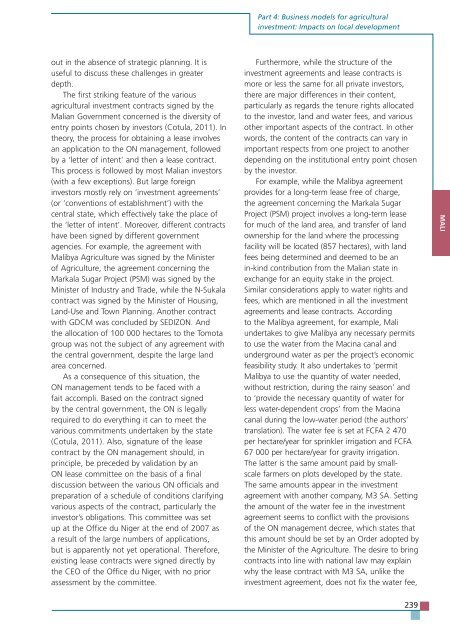TRENDS AND IMPACTS OF FOREIGN INVESTMENT IN DEVELOPING COUNTRY AGRICULTURE
TRENDS AND IMPACTS OF FOREIGN INVESTMENT IN DEVELOPING COUNTRY AGRICULTURE
TRENDS AND IMPACTS OF FOREIGN INVESTMENT IN DEVELOPING COUNTRY AGRICULTURE
You also want an ePaper? Increase the reach of your titles
YUMPU automatically turns print PDFs into web optimized ePapers that Google loves.
out in the absence of strategic planning. It is<br />
useful to discuss these challenges in greater<br />
depth.<br />
The first striking feature of the various<br />
agricultural investment contracts signed by the<br />
Malian Government concerned is the diversity of<br />
entry points chosen by investors (Cotula, 2011). In<br />
theory, the process for obtaining a lease involves<br />
an application to the ON management, followed<br />
by a ‘letter of intent’ and then a lease contract.<br />
This process is followed by most Malian investors<br />
(with a few exceptions). But large foreign<br />
investors mostly rely on ‘investment agreements’<br />
(or ‘conventions of establishment’) with the<br />
central state, which effectively take the place of<br />
the ‘letter of intent’. Moreover, different contracts<br />
have been signed by different government<br />
agencies. For example, the agreement with<br />
Malibya Agriculture was signed by the Minister<br />
of Agriculture, the agreement concerning the<br />
Markala Sugar Project (PSM) was signed by the<br />
Minister of Industry and Trade, while the N-Sukala<br />
contract was signed by the Minister of Housing,<br />
Land-Use and Town Planning. Another contract<br />
with GDCM was concluded by SEDIZON. And<br />
the allocation of 100 000 hectares to the Tomota<br />
group was not the subject of any agreement with<br />
the central government, despite the large land<br />
area concerned.<br />
As a consequence of this situation, the<br />
ON management tends to be faced with a<br />
fait accompli. Based on the contract signed<br />
by the central government, the ON is legally<br />
required to do everything it can to meet the<br />
various commitments undertaken by the state<br />
(Cotula, 2011). Also, signature of the lease<br />
contract by the ON management should, in<br />
principle, be preceded by validation by an<br />
ON lease committee on the basis of a final<br />
discussion between the various ON officials and<br />
preparation of a schedule of conditions clarifying<br />
various aspects of the contract, particularly the<br />
investor’s obligations. This committee was set<br />
up at the Office du Niger at the end of 2007 as<br />
a result of the large numbers of applications,<br />
but is apparently not yet operational. Therefore,<br />
existing lease contracts were signed directly by<br />
the CEO of the Office du Niger, with no prior<br />
assessment by the committee.<br />
Part 4: Business models for agricultural<br />
investment: Impacts on local development<br />
Furthermore, while the structure of the<br />
investment agreements and lease contracts is<br />
more or less the same for all private investors,<br />
there are major differences in their content,<br />
particularly as regards the tenure rights allocated<br />
to the investor, land and water fees, and various<br />
other important aspects of the contract. In other<br />
words, the content of the contracts can vary in<br />
important respects from one project to another<br />
depending on the institutional entry point chosen<br />
by the investor.<br />
For example, while the Malibya agreement<br />
provides for a long-term lease free of charge,<br />
the agreement concerning the Markala Sugar<br />
Project (PSM) project involves a long-term lease<br />
for much of the land area, and transfer of land<br />
ownership for the land where the processing<br />
facility will be located (857 hectares), with land<br />
fees being determined and deemed to be an<br />
in-kind contribution from the Malian state in<br />
exchange for an equity stake in the project.<br />
Similar considerations apply to water rights and<br />
fees, which are mentioned in all the investment<br />
agreements and lease contracts. According<br />
to the Malibya agreement, for example, Mali<br />
undertakes to give Malibya any necessary permits<br />
to use the water from the Macina canal and<br />
underground water as per the project’s economic<br />
feasibility study. It also undertakes to ‘permit<br />
Malibya to use the quantity of water needed,<br />
without restriction, during the rainy season’ and<br />
to ‘provide the necessary quantity of water for<br />
less water-dependent crops’ from the Macina<br />
canal during the low-water period (the authors’<br />
translation). The water fee is set at FCFA 2 470<br />
per hectare/year for sprinkler irrigation and FCFA<br />
67 000 per hectare/year for gravity irrigation.<br />
The latter is the same amount paid by smallscale<br />
farmers on plots developed by the state.<br />
The same amounts appear in the investment<br />
agreement with another company, M3 SA. Setting<br />
the amount of the water fee in the investment<br />
agreement seems to conflict with the provisions<br />
of the ON management decree, which states that<br />
this amount should be set by an Order adopted by<br />
the Minister of the Agriculture. The desire to bring<br />
contracts into line with national law may explain<br />
why the lease contract with M3 SA, unlike the<br />
investment agreement, does not fix the water fee,<br />
239<br />
MALI


